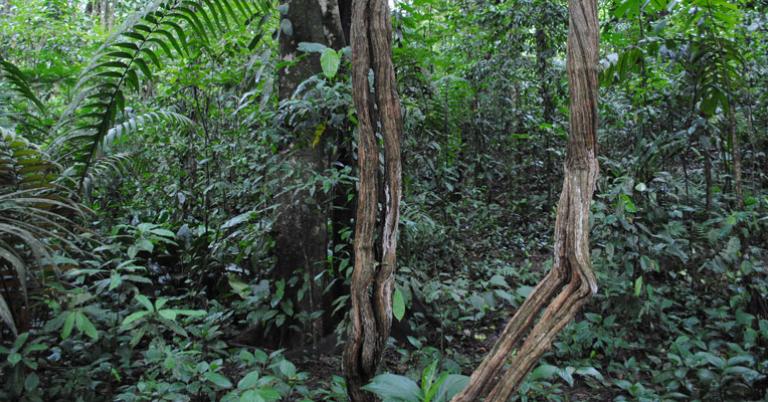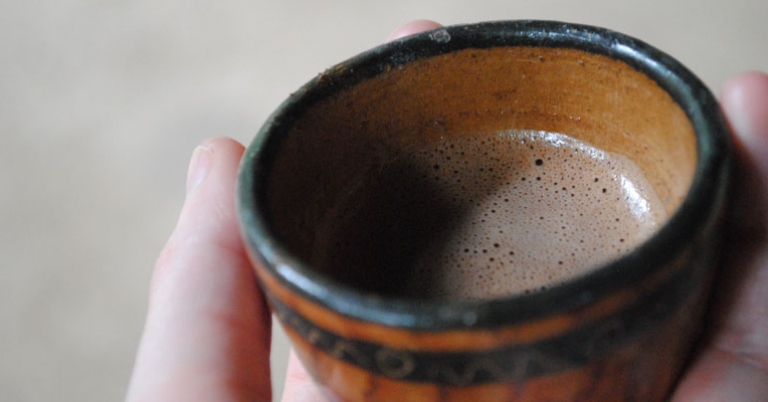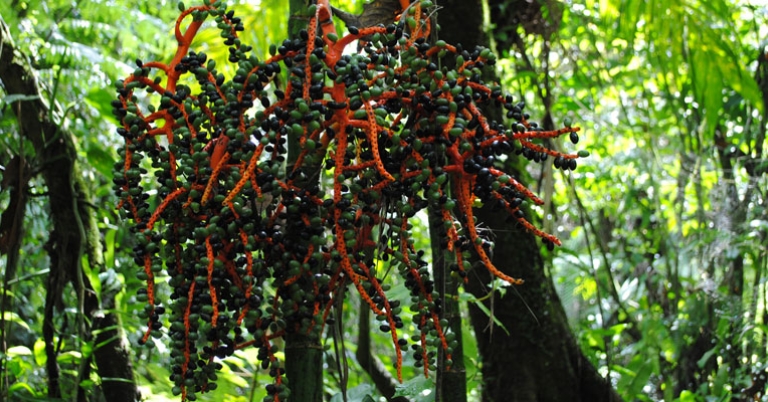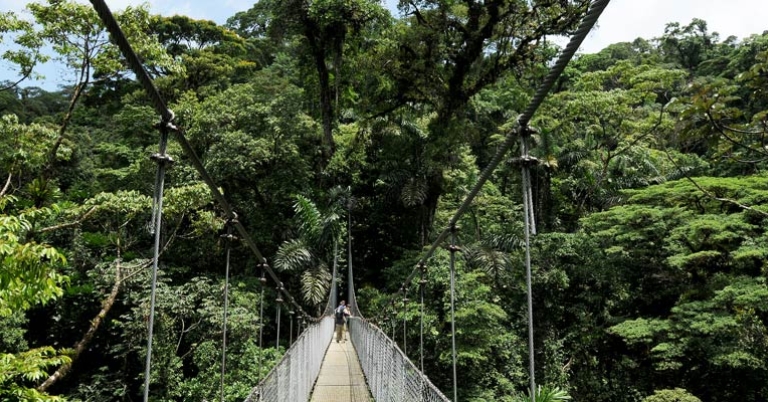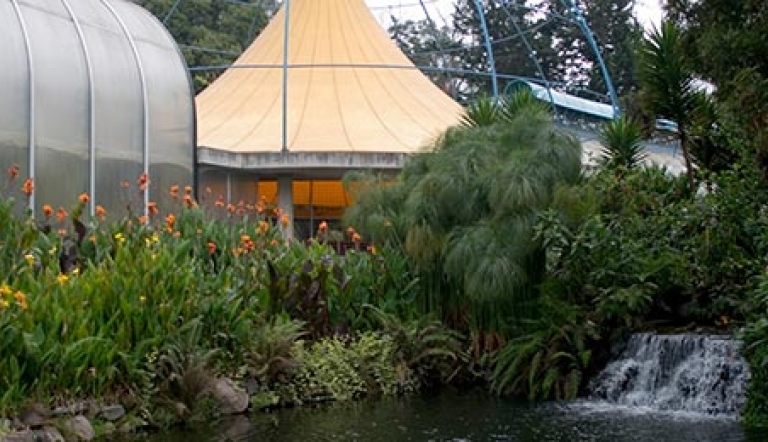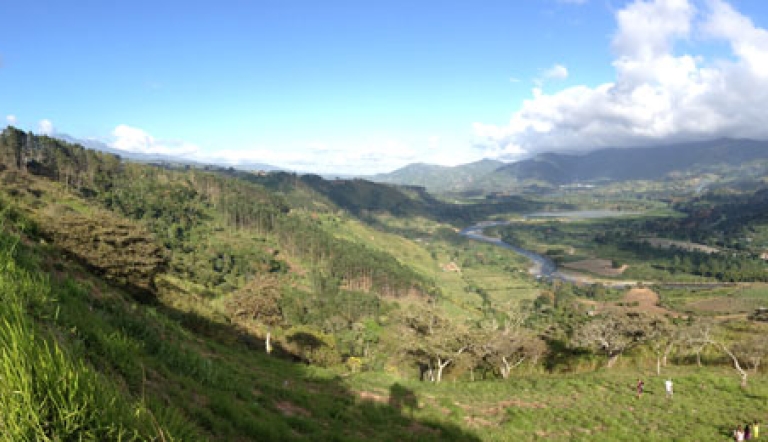Costa Rica | Gardens, Forests, Wildlife and the Sea with San Diego Botanic Garden
About this trip
 The lush and varied ecosystems of Costa Rica are abundant with tropical plants, diverse wildlife, and colorful birds. For serious garden lovers, this 13-day itinerary is the perfect opportunity to sample the best of the country’s biodiversity. Join Julian and Leslie Duval on this journey and become immersed in the vibrant flora of different types of forests, including cloud forest, rainforest, premontane forest, and tropical dry forest. Walk beneath towering 700-year-old trees and learn about innovative conservation projects. From visits to world-renowned tropical research institutions and behind-the-scenes tours at botanical gardens, to guided trail hikes and boating excursions,this program takes a multifaceted look at the country’s floristic heritage.
The lush and varied ecosystems of Costa Rica are abundant with tropical plants, diverse wildlife, and colorful birds. For serious garden lovers, this 13-day itinerary is the perfect opportunity to sample the best of the country’s biodiversity. Join Julian and Leslie Duval on this journey and become immersed in the vibrant flora of different types of forests, including cloud forest, rainforest, premontane forest, and tropical dry forest. Walk beneath towering 700-year-old trees and learn about innovative conservation projects. From visits to world-renowned tropical research institutions and behind-the-scenes tours at botanical gardens, to guided trail hikes and boating excursions,this program takes a multifaceted look at the country’s floristic heritage.
Highlights
- Explore the impressive collections of palms, gingers, cycads,bromeliads, and more at Else Kientzler and Wilson Botanical Gardens.
- Examine some of the country’s 1,300-plus orchid species at SACRO, a non-profit orchid conservation organization.
- Learn about the research underway at the Organization for Tropical Studies Las Cruces Biological Station during a site lecture by the director.
- Hike amid ancient trees and watch for Scarlet Macaws in the transitional forest at Carara National Park.
- Embark on a twilight boat safari, stopping at a local farm for atypical Costa Rican snack.
Meet your leaders
 Julian and Leslie Duval
Julian and Leslie Duval
Julian Duval is a native of the Chicago area and a bona fide Nature Nut. He graduated from New Mexico State University with a degree in Animal Management, joined the Peace Corps, lived in the Dominican Republic and Guatemala before returning to the States. He worked at the Indianapolis Zoo for 15 years before taking a job in beautiful Encinitas, CA at the Quail Botanical Gardens (now the San Diego Botanic Garden). He retired in 2019 keeping the title of President/CEO Emeritus and continues to lead trips for the Garden.
Leslie Berling Duval was born in Indianapolis and is a happily retired Pediatric Operating Room RN. Since meeting Julian in 1980, life has been full of travel and fascinating friends from all over the world. She enjoys caring for their 4-legged family, cooking, camping, hiking, and of course traveling. After retirement, she wrote an award winning children’s book: TOO BIG TO LOSE, a heartwarming story based on the true story of Julian’s childhood pet SAM... a Galapagos Tortoise!
$4,095
Per person
About this price
Land cost only. Does not include round-trip airfare to and from destination.
Single room supplement $785
What makes us different
Rich content
Carbon offsetting
Wildlife up-close
Behind the scenes tours
Diverse ecosystems
Flight arrangements
Daily Itinerary
Print ItinerarySanto Domingo
Arenal
Arenal
Sarapiquí
Sarapiquí
Tárcoles/Pacific
Tárcoles/Pacific
San Vito
San Vito
San Gerardo de Dota
San Gerardo de Dota
Santo Domingo
Departure
Pricing
Print Pricing$4,095
Per person
About this price
Land cost only. Does not include round-trip airfare to and from destination.
Single room supplement $785
What's Included
- Accommodations with private bathrooms
- Activities and meals as mentioned in itinerary
- All tips
- Arrival and departure transfers based on individual flight schedules
- Carbon Offset
- Full time expert horticulture guide for the duration of your program
- Non alcoholic beverage with meals
What's Not Included
- International airfare
- Items of personal nature
- Travel Insurance
Pricing Details
A $500 per person deposit and enrollment form is due to hold your space on this trip. This deposit is refundable 95 days prior to departure excluding a $300 cancellation fee. Cancellations after this date are non refundable.
Holbrook Travel strongly recommends the purchase of travel protection for medical emergencies while traveling and to protect your investment. Please note the purchase of Cancel for Any Reason Coverage or to exclude pre-existing conditions with Trip Cancellation coverage may require policy purchase within 10-14 days of your initial deposit, depending upon the provider.
Single room supplement $785
Final payment due date: August 24, 2023
Travel Info
Print Travel InfoEntry & Exit Requirements
U.S. citizens must have a valid passport to enter Costa Rica. Passports must be valid for at least the duration of your stay. As this requirement is subject to change at any time without notice, we recommend at least 6 months' validity.
A visa is not required for visits up to 90 days.
If you are not traveling with a U.S. passport, please check with the Costa Rican Embassy for the requirements based on your nationality.
Health Information
IMMUNIZATIONS
The Centers for Disease Control recommends that all travelers be up to date on routine vaccinations such as measles-mumps-rubella (MMR) vaccine, diphtheria-pertussis-tetanus vaccine, varicella (chicken pox) vaccine, and your yearly flu shot before every trip.
There are no vaccinations required for entry into Costa Rica, unless you are traveling from a country where yellow fever transmission is a risk.
The CDC recommends vaccination against hepatitis A, hepatitis B, and typhoid for most unvaccinated travelers to Costa Rica.
Please consult your physician for additional information and recommendations based on your individual circumstances.
MALARIA
Malaria is caused by a parasite found in Anopheles mosquitos, which are active from dusk until dawn. The CDC advises that the risk of malaria in Costa Rica is low, but travelers should still take precautions against mosquito bites. Cover exposed skin with lightweight, long-sleeved shirts and pants, consider treating clothes with permethrin, and use an insect repellent containing an active ingredient like DEET or picaridin. Apply sunscreen first, followed by the repellent (preferably 20 minutes later).
DENGUE FEVER & OTHER INSECT-BORNE ILLNESSES
Locally transmitted cases of dengue fever have been reported in Costa Rica. Local transmission means that mosquitoes in the area have been infected with dengue and are spreading it to people. In addition, locally transmitted cases of chikungunya, Zika virus, and other insect-borne illnesses have previously been reported in Costa Rica.
Travelers to Costa Rica should protect themselves against insect bites using the measures described above. As a precaution, the CDC advises women who are pregnant to consider postponing travel to any area where Zika virus transmission is ongoing.
SUN EXPOSURE
The effects of the sun can be damaging to the eyes and skin. Spending time outdoors exposes you to the sun’s harmful ultraviolet (UV) rays, even on cloudy days. To protect yourself from the sun, use a broad spectrum sunscreen of at least SPF 15, protect skin with clothing, wear a wide-brimmed hat and sunglasses, and drink plenty of fluids.
ALTITUDE SICKNESS
If your itinerary includes locations at high elevation (above 5,000 feet), altitude sickness is a possibility. Stay hydrated and well-rested, and avoid heavy, fatty foods and alcohol in the days before arrival. Consult your physician prior to travel for advice specific to your situation.
Resources
Print ResourcesPacking Recommendations
Everyone has personal preferences when it comes to packing; for this reason, the information below is offered as a general guide and not a definitive list. You know yourself best: Use your discretion and pack what you think will serve you, based on your personal preferences and specific itinerary.
You may find many of the items below in our Gear Store.
CLOTHING
Casual, comfortable clothing is suitable for most activities in Costa Rica. You may wish to bring a slightly nicer outfit or two (eg sundress, polo shirt) if your itinerary includes dinners out or more formal activities.
Bring enough clothing suitable for the length of your program. If you prefer to pack light, note that many hotels offer laundry services at additional cost. If you plan to hand-wash items, remember that humidity may delay drying time.
Pack clothing that can be worn in layers to adapt to weather changes throughout the day. Costa Rica’s rainy season is May through November, but it can rain at any time. Clothing that wicks away moisture and dries quickly is recommended.
If your program includes visits to higher elevations (e.g. Savegre, Monteverde, or Cordillera de Talamanca), warm clothing is strongly recommended. Temperatures can get quite chilly, especially at night and early in the morning, and hotel rooms don’t always have heat. It can also be windy at times. Consider packing a warm underlayer, as well as a warm, protective outer layer.
For birding programs, pack muted colors such as khaki, olive, and forest green. If participating in turtle patrols, bring dark-colored pants and shirts.
- A combination of short-sleeved and lightweight, long-sleeved shirts for sun and mosquito protection
- Shorts
- Lightweight, quick-drying long pants for sun and mosquito protection; jeans tend to be uncomfortable in hot and humid conditions, but are fine in the cooler highlands.
- Undergarments
- Sleepwear
- Lightweight jacket or sweater/sweatshirt (or heavier weight if visiting high-elevation areas)
- 1-2 bathing suit(s) for the beach, if applicable, plus many hotels have pools
- Socks – Bring extra pairs. If your itinerary indicates muddy hikes with rubber boots provided on-site, pack a few pairs of knee socks to prevent blisters.
- Shoes – Consider your specific itinerary when choosing footwear. For most programs, you’ll likely want at least one pair of comfortable, closed-toe walking or hiking shoes suitable for forest hikes and walking over cobblestones or other uneven terrain. Sturdier hiking boots may be appropriate for more active itineraries. In addition, many participants opt for a pair of sturdy sport-strap sandals (e.g. Keens, Tevas, or similar) and/or casual flip-flops or sandals. If you’re whitewater rafting or visiting the beach, you may also want a pair of aqua socks, reef walkers, or water shoes.
- Lightweight rain jacket, hooded poncho, and/or windbreaker
- Visor or wide-brimmed sun hat
- Bandana, scarf, or neck gaiter
Personal Toiletries
Pack toiletries based on your personal preferences and habits. Below are just a few recommendations to keep in mind.
- Shampoo, conditioner, lotion, deodorant/antiperspirant , etc. – If possible, avoid strong fragrances if you are sensitive to insect bites (and to be considerate of you fellow travelers).
- Soap and washcloth or a small, quick-drying microfiber towel – Washcloths are not standard in all hotels. If you normally use a washcloth, you may wish to bring one from home.
- Hairbrush, comb, hair ties, shower cap. Most—but not all—hotel rooms provide a hair dryer, but you may wish to bring one from home.
- Toothbrush and toothpaste
- Razor
- Ear plugs, especially if you are a light sleeper
- Personal hygiene products
- Insect repellent with DEET or picaridin (see note below about treating clothing with permethrin)
- Sunscreen and lip balm with SPF – If you’ll be in the ocean, we recommend reef-safe sunscreen.
- Aloe vera gel
- A travel pack of tissues – also useful as napkins or toilet paper if needed
In addition to your personal toiletries, it is useful to pack a small medical kit, which you can easily prepare. Helpful items might include: bandages, antihistamine, a pain reliever, motion sickness and/or altitude sickness medication (if you are prone to either), anti-diarrhea medicine, individually wrapped pre-moistened towelettes and/or hand sanitizer, antibiotic ointment, anti-fungal cream, moleskin for blisters, eye drops, tweezers, a mini sewing kit, and an extra pair of disposable contact lenses or eyeglasses if you wear them.
Days before you leave home, you may wish to consider spraying any clothing, socks, and shoes that will be worn in lowland, tropical sites with permethrin, an anti-parasite medication, to repel irritating pests and prevent the spread of disease. A recommended brand is Sawyer. Carefully read all instructions before use. Please note permethrin is highly toxic to cats and fish, and some aerosol products may be harmful to birds. Side effects may include minor itching, burning, or redness. You may want to use a laundry marker to label and keep track of which socks are permethrinized. Only one application per item is necessary; permethrin on treated clothes remains effective through several washings. Permethrin should NOT be applied directly to skin.
Miscellaneous
Remember to pack valuables such as your passport, cash/credit cards, and medications in your carry-on luggage.
- Passport and photocopies of all travel documentation
- Personal insurance card and travel insurance information
- Money – ATM/credit card, traveler's checks, and/or cash; small bills in good condition are recommended
- Prescription medicines (if applicable), with a copy of the prescription
- Yellow fever certificate (if required; only if arriving from a country where yellow fever transmission is a risk)
- Sunglasses with strap
- Small day pack for hikes and excursions
- Flashlight and/or head lamp
- Travel alarm clock or inexpensive waterproof wristwatch with alarm – Not all hotels provide alarm clocks.
- A pocket calculator or phone to assist with conversions and currency exchange
- Binoculars with lens cleaner
- Camera and related equipment, such as charger, lenses, and extra memory cards
- Reusable water bottle – especially important in national parks, which do not permit single-use plastic bottles or containers
- Non-perishable snacks
- Pocket-knife or multipurpose tool - Pack in your checked luggage
- Zip-top style bags – useful for packing toiletries, sorting clothing, storing damp or muddy shoes, or as a dry bag for protecting electronics
- Notepad or travel journal and pen
- Music or reading material for down time, long bus drives, or on the airplane, and a portable bright light to read by
- Collapsible walking stick with rubber tip
- A small quantity of laundry detergent if you’ll be washing clothing by hand
- Travel-size umbrella – Some people find this unwieldy to carry, while others find it offers better protection than a rain jacket alone.
- Money belt
- Chargers for electronics

Questions
Contact Sandy Schmidt at 877-907-5360 or email Sandy.
